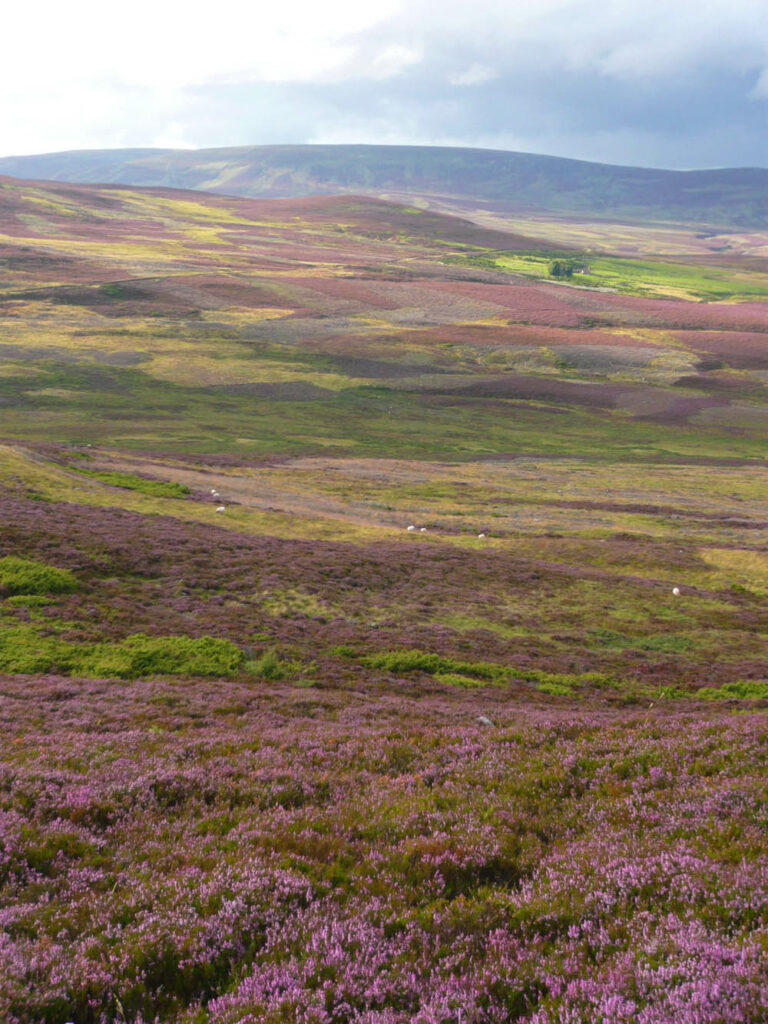Claim
75% of the world’s heather moorland is found in the UK.
What the science says
Unsubstantiated.
The figure that 75% of the world’s heather moorland, or upland heather moorland (quoted differently in different places), is found in the UK has been repeated by many organisations over recent decades. However, the two occurrences that we found in the scientific literature were not supported by the citations given. We are not aware of published scientific work that determines what percentage of the world’s upland heather moorland is held in the UK.
Based on
This figure is widely quoted by many interested parties, holding different views about the management of such environments:
- Ecologist: Grouse Shooters Thrive on Heather Moorlands
- Climate News Network: ‘Amazon of UK’ being destroyed for grouse shooting
- The Moorland Association
- Game & Wildlife Conservation Trust: How much upland heather moorland is in the UK?
- BASC: Grouse Moor Landscape
The assertion was recently challenged by Dr Steve Carver on his blog.
The fuller picture

The first important point is to clarify what we are asking. Across the sources that use the 75% claim, there are three groups of terms used, which are broadly: the UK has 75% of the world’s ‘moorland’, ‘heather moorland’ and ‘upland heather moorland’. These three are very different categories, getting progressively more specific and defined (and correspondingly less common worldwide).
Moorland is found across the world with many vegetation types. Heather-dominated moorland is a much more specific definition1 – common heather (the scientific name is Calluna vulgaris) is found naturally only in northern Europe, and upland heather moorland restricts the definition further, by discounting lowland ecosystems. As each extra adjective is added to the habitat description, and the area worldwide that fits this bill shrinks, one might expect the relative proportion found in the UK to rise. Those who are engaging in this debate are usually concerned with the activities and management associated with driven grouse shooting in the UK – an activity that currently takes place only in the upland environment in the UK – so arguably ‘upland heather moorland’ is the most appropriate selection under these circumstances.
Published literature
The 75% claim has been repeated across many websites, leaflets and other so-called ‘grey literature’, but in trying to trace the source, WTSS focuses first on the published scientific literature.
The figure that 75% of the world’s heather moorland is found in UK habitats occurs in at least two peer-reviewed papers2,3, citing two different original sources4,5.
Firstly, Joe Holden’s review paper ‘Environmental change in moorland landscapes’, published in 2007 in Earth Science Reviews, states that “seventy-five percent of the world’s heather moorland is in the UK uplands”2, citing a conference proceedings paper from 1998 authored by JH Tallis and colleagues4.
This was followed in 2010 by a paper by Nicholas Aebischer, following a presentation given at a symposium of the World Forum on Shooting Activities3. This paper says that: “Internationally, the United Kingdom holds 75% of the world’s upland heather moorland, the rest being in Ireland, coastal Norway and in limited areas elsewhere”, giving the source as a paper published in 1979 by Prof Gimingham, a world expert in this field at that time5. What The Science Says was not able to find information in either of the two quoted sources4,5 that states explicitly what percentage of the world’s heather moorland is found in the UK. A sketch map of Europe based on information from the 1970s and 80s is reproduced in one paper on this subject, roughly outlining some areas of upland heather moorland in Europe and also not giving a figure1.
Other sources
Widening the search to look at reports and other sources gives more information, but once again it is important to be mindful of exactly what we are asking. For example, the National Heathland Conference Proceedings from 1996 presents how much lowland heathland various countries hold, as submitted to the EU under Article 17 of the Habitat’s directive6 (a useful discussion of this is found in Steve Carver’s blog). Although when the upland figures are added on for the UK the total comes almost to 75% in the UK, it includes information from only seven EU countries, and refers to their heather-dominated lowland heathland, not their heather-dominated upland moorland – so does not support the claim.
Another possible source is the European Commission’s report from 2008 on Management of the Northern Atlantic wet heaths with Erica tetralix7 (this is another of the heather family, which broadly shares its habitat and range with common heather). Considering this habitat alone, the report says North Atlantic wet heath is restricted in its distribution to the Atlantic fringe between Scandinavia and Normandy.
The majority of the wet heath resource in the EU is in the UK and Ireland (85%) and it spans upland (up to 600m) and lowland altitudes (below 300m). In the UK wet heath is usually found in the wetter climates of the north and west, and in Sweden it is restricted to regions in south-western parts of the country with similar climate conditions.
A map in this report clarifies that 23% is found in Ireland and around 60% in the UK. However, once again although wet heath with Erica tetralix is closer in definition to upland heather moorland, it is only one of several habitats that would be considered part of that description. This information also covers lowland as well as upland wet heath.
Moving on to mapping tools, the EU’s European Nature Information System (EUNIS) is a classification system that categorises habitats across Europe, based on various criteria including the dominant vegetation present, humidity and human usage. It is never straightforward to classify the real world into defined boxes, and any exercise like this includes some uncertainty – for example, different opinions as to dominant vegetation, the transition between sites that are classified as one habitat neighbouring another and the gradual change between them, and how the EUNIS system relates to other, national-level habitat classification. Work is ongoing to reduce some of this uncertainty by defining EUNIS habitat classification more clearly and developing automated systems to assign known vegetation plots to a particular category accurately8.
EUNIS is a layered classification system, with the top tier defining which of six broad categories an area falls into (these six main habitat types were recently reorganised from a previous ten):
- Coastal habitats
- Wetlands
- Grasslands and lands dominated by forbs, mosses or lichens
- Heathlands, scrub and tundra
- Forests and other wooded land
- Vegetated man-made habitats.
Even from these six broadest habitat classifications, we see that ‘upland heather moorland’ doesn’t sit neatly into any of the categories, with areas falling into at least two of these groups: predominantly wetlands (subgroup blanket bog); or heathlands, scrub and tundra (subgroup temperate heathland); but also with smaller areas in other categories. Although an invaluable resource in many ways, the EUNIS data system does not either support the 75% claim or easily answer the wider question of how much upland heather moorland is found in different European countries.
Conclusion

The fundamental problem with applying modern mapping systems to the 75% claim is that there is a mismatch between the general working description of ‘upland heather moorland’, a term that was coined before detailed habitat definitions and classifications were common, and the categories that are now used to classify and quantify habitats. We have not been able to identify the source of the claim that 75% of upland heather moorland is found in the UK. It seems likely that an informal estimate was made based on the limited information available at the time1, which was accepted and reproduced through interested parties.
Donate and help us fight misinformation
References
- Thompson, D.B., MacDonald, A.J., Marsden, J.H. & Galbraith, C. (1995). Upland heather moorland in Great Britain: A review of international importance, vegetation change and some objectives for nature conservation. Biological Conservation, 71:163–178.
- Holden, J., Shotbolt, L., Bonn, A., Burt, T.P., Chapman, P.J., Dougill, A.J., Fraser, E.D.G., Hubacek, K., Irvine, B., Kirkby, M.J., Reed, M.S., Prell, C., Stagl, S., Stringer, L.C., Turner, A. & Worrall, F. (2007). Environmental change in moorland landscapes. Earth-Science Reviews, 82:75–100.
- Aebischer, N.A., Ewald, J.A. & Tapper, S.C. (2010). Driven grouse shooting in Britain: a form of upland management with wider conservation benefits. In: Ecologic and Economic Benefits of Hunting: 186–201. (ed. Allen, P.) World Forum on the Future of Sport Shooting Activities. Rome.
- Tallis, J.H., Meade, R. & Hulme, P.D. (1998). Introduction. In: Blanket Mire Degradation: Causes Consequences and Challenges: 1–2. (eds. Tallis, J.H., Meade, R. & Hulme, P.D.) British Ecological Society. London.
- Gimingham, C.H., Chapman, S.B. & Webb, N.R. (1979). European Heathlands. In: Ecosystems of the world Vol 9A. Heathlands and related shrublands: 365–413. (ed. Specht, R.L.) Elsevier. Amsterdam.
- Diemont, W.H., Webb, N. & Degn, H.J. (1996). A pan-European view on heathland conservation. In: Proceedings National Heathland Conference: 21–32. New Forest, Hampshire.
- Hampton, M. (2008). Management of Natura 2000 habitats. 4010 Northern Atlantic wet heaths with Erica tetralix. Brussels.
- Chytrý, M., Tichý, L., Hennekens, S.M., Knollová, I., Janssen, J.A.M., Rodwell, J.S., Peterka, T., Schaminée, J.H.J., et al. (2020). EUNIS Habitat Classification: Expert system, characteristic species combinations and distribution maps of European habitats. Applied Vegetation Science, doi:10.1111/avsc.12519